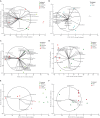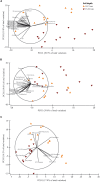Interaction Between Conservation Tillage and Nitrogen Fertilization Shapes Prokaryotic and Fungal Diversity at Different Soil Depths: Evidence From a 23-Year Field Experiment in the Mediterranean Area
- PMID: 31551981
- PMCID: PMC6737287
- DOI: 10.3389/fmicb.2019.02047
Interaction Between Conservation Tillage and Nitrogen Fertilization Shapes Prokaryotic and Fungal Diversity at Different Soil Depths: Evidence From a 23-Year Field Experiment in the Mediterranean Area
Abstract
Soil biodiversity accomplishes key roles in agro-ecosystem services consisting in preserving and enhancing soil fertility and nutrient cycling, crop productivity and environmental protection. Thus, the improvement of knowledge on the effect of conservation practices, related to tillage and N fertilization, on soil microbial communities is critical to better understand the role and function of microorganisms in regulating agro-ecosystems. In the Mediterranean area, vulnerable to climate change and suffering for management-induced losses of soil fertility, the impact of conservation practices on soil microbial communities is of special interest for building mitigation and adaptation strategies to climate change. A long-term experiment, originally designed to investigate the effect of tillage and N fertilization on crop yield and soil organic carbon, was utilized to understand the effect of these management practices on soil prokaryotic and fungal community diversity. The majority of prokaryotic and fungal taxa were common to all treatments at both soil depths, whereas few bacterial taxa (Cloacimonates, Spirochaetia and Berkelbacteria) and a larger number of fungal taxa (i.e., Coniphoraceae, Debaryomycetaceae, Geastraceae, Cordicypitaceae and Steccherinaceae) were unique to specific management practices. Soil prokaryotic and fungal structure was heavily influenced by the interaction of tillage and N fertilization: the prokaryotic community structure of the fertilized conventional tillage system was remarkably different respect to the unfertilized conservation and conventional systems in the surface layer. In addition, the effect of N fertilization in shaping the fungal community structure of the surface layer was higher under conservation tillage systems than under conventional tillage systems. Soil microbial community was shaped by soil depth irrespective of the effect of plowing and N addition. Finally, chemical and enzymatic parameters of soil and crop yields were significantly related to fungal community structure along the soil profile. The findings of this study gave new insights on the identification of management practices supporting and suppressing beneficial and detrimental taxa, respectively. This highlights the importance of managing soil microbial diversity through agro-ecological intensified systems in the Mediterranean area.
Keywords: 16S rRNA; Glomeromycota; ITS1 region; Illumina sequencing; arbuscular mycorrhizal fungi; soil archaea; soil bacteria; soil fungi.
Figures





Similar articles
-
Fungal community profiles in agricultural soils of a long-term field trial under different tillage, fertilization and crop rotation conditions analyzed by high-throughput ITS-amplicon sequencing.PLoS One. 2018 Apr 5;13(4):e0195345. doi: 10.1371/journal.pone.0195345. eCollection 2018. PLoS One. 2018. PMID: 29621291 Free PMC article.
-
Microbial Communities Associated With Long-Term Tillage and Fertility Treatments in a Corn-Soybean Cropping System.Front Microbiol. 2020 Jun 25;11:1363. doi: 10.3389/fmicb.2020.01363. eCollection 2020. Front Microbiol. 2020. PMID: 32670235 Free PMC article.
-
Mycorrhizal effects on crop yield and soil ecosystem functions in a long-term tillage and fertilization experiment.New Phytol. 2024 May;242(4):1798-1813. doi: 10.1111/nph.19493. Epub 2023 Dec 28. New Phytol. 2024. PMID: 38155454
-
Agricultural management practices to sustain crop yields and improve soil and environmental qualities.ScientificWorldJournal. 2003 Aug 20;3:768-89. doi: 10.1100/tsw.2003.62. ScientificWorldJournal. 2003. PMID: 12941975 Free PMC article. Review.
-
Advocating microbial diversity conservation in Antarctica.NPJ Biodivers. 2025 Mar 4;4(1):5. doi: 10.1038/s44185-025-00076-8. NPJ Biodivers. 2025. PMID: 40038369 Free PMC article. Review.
Cited by
-
Crop Management Impacts the Soybean (Glycine max) Microbiome.Front Microbiol. 2020 Jun 3;11:1116. doi: 10.3389/fmicb.2020.01116. eCollection 2020. Front Microbiol. 2020. PMID: 32582080 Free PMC article.
-
Isolation and Screening of Extracellular PGPR from the Rhizosphere of Tomato Plants after Long-Term Reduced Tillage and Cover Crops.Plants (Basel). 2020 May 25;9(5):668. doi: 10.3390/plants9050668. Plants (Basel). 2020. PMID: 32466288 Free PMC article.
-
Topsoil Bacterial Community Changes and Nutrient Dynamics Under Cereal Based Climate-Smart Agri-Food Systems.Front Microbiol. 2020 Jul 28;11:1812. doi: 10.3389/fmicb.2020.01812. eCollection 2020. Front Microbiol. 2020. PMID: 32849419 Free PMC article.
-
Tillage Practices and Residue Management Manipulate Soil Bacterial and Fungal Communities and Networks in Maize Agroecosystems.Microorganisms. 2022 May 20;10(5):1056. doi: 10.3390/microorganisms10051056. Microorganisms. 2022. PMID: 35630498 Free PMC article.
-
Climate-smart agricultural practices influence the fungal communities and soil properties under major agri-food systems.Front Microbiol. 2022 Dec 13;13:986519. doi: 10.3389/fmicb.2022.986519. eCollection 2022. Front Microbiol. 2022. PMID: 36583046 Free PMC article.
References
-
- Ai C., Zhang S., Zhang X., Guo D., Zhou W., Huang S. (2018). Distinct responses of soil bacterial and fungal communities to changes in fertilization regime and crop rotation. Geoderma 319 156–166. 10.1016/j.geoderma.2018.01.010 - DOI
-
- Alguacil M. M., Torrecillas E., García-Orenes F., Roldán A. (2014). Changes in the composition and diversity of AMF communities mediated by management practices in a Mediterranean soil are related with increases in soil biological activity. Soil Biol. Biochem. 76 34–44. 10.1016/j.soilbio.2014.05.002 - DOI
-
- Anderson M. J. (2001). A new method for non-parametric multivariate analysis of variance. Austral Ecol. 26 32–46. 10.1111/j.1442-9993.2001.01070.pp.x - DOI
LinkOut - more resources
Full Text Sources

